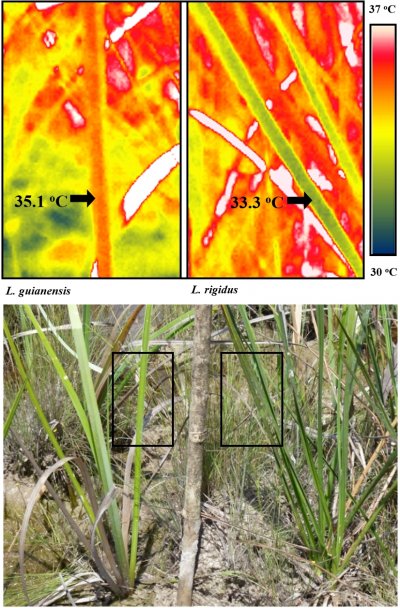Plants can avoid overheating by regulating the components of their energy budget. The amount of solar radiation intercepted can be reduced using specialised leaf and canopy arrangements. The vertical leaves and canopy architecture of many eucalyptus trees are arranged to minimise the area of the canopy exposed to direct sun (as a consequence they cast a relatively small shadow). Other species, such as dragon trees (Dracaena spp.) and some acacia trees, adopt an umbrella-like form to raise the canopy above the warm ground and shade the trunk. Some species employ leaf movements, rolling their leaves or changing leaf orientation so that the surfaces are never parallel to the sun. Leaf movements are particularly common in legumes (Fabaceae).
The amount of incident radiation absorbed by a leaf can be reduced by increasing the reflectance of the leaf surface. Leaf hairs and scales scatter the incident radiation such that the leaf appears silvery white, e.g. the sagebrush (Artemisia tridentata) and the brittlebush (Encelia farinosa) common in many arid areas of North America. Pubescence is common in hot, dry environments, where as well as reflecting solar radiation, leaf hairs form a thick boundary layer reducing water loss (although this also reduces the potential for transpirational cooling). Such adaptations are so common among plants of warm arid and high altitude regions that these habitats can be seen to form a ‘silvery landscape’. Waxes deposited on the epidermis perform a similar function, preventing water loss and forming an irregular surface to increase reflectance.
The amount of heat lost can also be regulated by favouring small or divided leaves that reduce the boundary layer allowing for greater convective cooling as well as more effective transpiration. Tropical savanna plants with smaller leaves are better able to keep cool in the full glare of the equatorial sun, while species with larger leaves are restricted to areas shaded by tree canopies (Figure 14.27). Small leaves are also a distinguishing feature of desert shrubs and trees.
An increase in air temperature reduces the relative humidity (increases the vapour pressure deficit), which increases the evaporative demand and the transpiration rate. Where water supply is restricted the stomata will close causing transpiration rate to fall, resulting in an increase in leaf temperature. Where water supply is not limiting, transpirational cooling is an effective form of heat avoidance. Transpirational cooling often reduces leaf temperatures to 5oC below ambient, while temperatures can be reduced by 15oC in extreme cases. This contrasts with plants growing in arid conditions where leaf temperatures may be 15oC or more above ambient. In agricultural environments, where high temperatures are not necessarily combined with water deficit, cultivars showing high stomatal conductance have been shown to be more resistant to heat stress. In fact, stomatal conductance measurements along with direct measurements of ‘canopy temperature depression’ are among the most valuable parameters for selecting cultivars for growth in warm environments. The recent application of infrared thermometers to examine canopy temperatures has provided a valuable method for directly measuring heat avoidance (Figure 14.27); http://www.plantstress.com/Articles/heat_m/heat_m.htm; http://www.plantstress.com/methods/IRT_protocol.htm).
